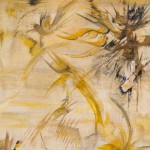Three new solo-exhibitions featuring works by A.L. Steiner, Anthony Burdin, and Drew Heitzler are currently on view at Blum & Poe in Los Angeles.
A.L. Steiner’s first solo-exhibition with the gallery, Come & Go, features works that span the last twenty years of the artist’s career and includes what Roberta Smith of The New York Times describes as “raunchy, out-there photographs of almost nothing but women having a blast being women.”
A.L. Steiner’s work is the agglomeration of her experiences. The daughter of a gallery owner, Steiner grew up in the midst of a thriving art world. This immersion provided her with a comprehensive understanding of art history, after which she pursued an education in communications, a choice that fueled a growing curiosity about the ways in which artists use their practice to promulgate their ideas and notions.
It wasn’t until later in Steiner’s career, however, that she took up fine art herself. While her work as a magazine photo editor helped to foster her provocative perspective, her affiliations with advocacy groups such as Queer Nation, the Women’s Action Coalition, and the Lesbian Avengers are what ultimately pushed her to employ art-making as a political platform.
Through photography, video, installation, collage, collaboration, performance, writing, and curatorial work, the self-described “skeptical queer eco-feminist androgyne” has since used her practice as a means to address marginalized subcultures. As iterated by Steiner in an interview with Courtney Yoshimura for Art Forum, she has spent much of the past two decades focusing on those who have had to grapple with “the notion of radical – whether as a self-identification or an imposed moniker.”
In addition to Steiner’s full-scale color pigment photographs, Come & Go features a relaxing space for viewers to peruse an immense archive of small scale prints, a collaboration with Shinichiro Okuda/WAKA WAKA, and live performances by Brave Accepter, Jibade-Khalil Huffman, and YACHT.
Anthony Burdin is also a first time exhibitor with Blum & Poe. His solo show, Fragments from Expeditions: Destitution, Deterioration, and Devastation, features several text-based paintings that beautifully bleed phrases painted in a pseudo-calligraphic style of writing. From afar, these works appear almost abstract. Yet upon close inspection, they reveal the artists’ satirical wit, which he cleverly uses to comment on how the media’s proliferation of banalities and buzzwords have undermined the power of free speech.
In another series of text-based paintings, Burdin continues his exploration of “colloquialisms” with his trademark graffiti technique, which he refers to as “Kookscrawl,” a clever play on words that can be read one of two ways. Comprising overused and clichéd phrases, these works again iterate society’s reliance upon trendy talking points as a means to impart judgment.
Two videos of Burdinʼs automatic performances, shallosscrave (2014) and Vape Lounge (2014), also occupy the show. Set within an installation of fictionalized landscapes that hang behind a coiled strand of gold barbed-wire, the videos convey the journey of a character named Desert Mix as he traverses his unimpressive claimed domains. Scattered with sight gags, the videos further emphasize Burdin’s reliance upon social satire as a means for commentary.
Pacific Palisades is Drew Heitzler’s third solo-show at Blum & Poe. Accentuating the artist’s unrelenting drive to find connections between disparate entities, Pacific Palisades “maps” how two groups of German and Austro-Hungarian émigrés have helped shape our current day perception of “lifestyle.”
The first group, once referred to as Weimar on the Pacific, included leftist and Jewish artists and intellectuals, invited to relocate to the States by Hollywood’s studios. As Hitler’s Europe became increasingly inhospitable, these cultural refugees found respite in the Palisades during the 1930ʼs. The second contingent arrived post WWII and included scientists and communications specialists. Recruited by NASA and the aerospace industry to help the US win the Space Race, this group also found refuge along the same coveted coastline.
Heitzler’s exhibition’s focal point is an exhaustive wall-sized diagram featuring hundreds of seemingly unrelated names such as Bertolt Brecht, Fritz Lang, Linda Carter and Ice Cube, each of whose lineage can be drawn back to the toney sea-cliff neighborhood at one time or another.
Heitzler’s other works on view include four water-based ink works on paper featuring texts authored by Max Horkheimer and Theodor W. Adorno, Thomas Mann, Aleister Crowley, and William Dudley Pelley; a series of sixteen water-based works on paper, each coated in resin and mounted on wood; a book of essays compiled by the artist, entitled Pacific Palisades; and, a large sculptural work produced from found driftwood, coated in white resin.
Rounding out this eclectic survey is a loop of “found footage” with the pliable green character of Gumby at the piano in a symphonic mash-up, streaming musical excerpts by Arnold Schoenberg, John Cage, Brian Wilson, Frank Zappa, Captain Beefheart, The Doors, Black Flag, and Easy-E, among others. Though almost absurdist, this video exemplifies Heitzler’s vision of Hollywood as a melting pot of incongruent histories and how such has greatly contributed to our collective aesthetics, socio-political thought, and technological advancement.
Come & Go, Fragments from Expeditions: Destitution, Deterioration, and Devastation, and Pacific Palisades will remain on exhibit at Blum & Poe through August 22.
Image credits: A.L. Steiner, Love Changes the Lover, 2015, color pigment photographs, courtesy of the artist and Blum & Poe. Anthony Burdin, False Flag, Pole Smoker, friendly, Neo Moderne Patio set, Faux Stonehenge, 2015, ink on canvas,16 x 20 inches (40.6 x 50.8 centimeters), courtesy of the artist and Blum & Poe. Drew Heitzler, Pacific Palisades (Dialectic of Enlightenment #1), 2015, solvent and water-based ink on Arches, 53 x 42 inches (134.6 x 106.7 centimeters), courtesy of the artist and Blum & Poe.
–Anise Stevens






